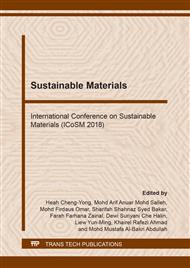p.96
p.102
p.109
p.115
p.121
p.127
p.134
p.142
p.151
Synthesis of WSi2-W5Si3 Intermetallic Alloy via Self-Propagating High Temperature Synthesis
Abstract:
Intermetallic alloy of tungsten silicide (WSi2-W5Si3) was synthesized by self-propagating high temperature synthesis (SHS) from the reactant of tungsten oxide (WO3) and silicon lump (Si) using magnesium (Mg) as fuel. The standard Gibbs energy minimization method was used to calculate the equilibrium composition of the possible reacting species. The as-SHS products were characterized by X-ray diffraction (XRD) technique. The magnesiothermic reaction process successfully synthesized dense of WSi2-W5Si3 intermetallic alloy. According to the experimental results, it can be proposed that the reaction also promotes the phase separation between alloy and oxide slag of the product.
Info:
Periodical:
Pages:
121-126
Citation:
Online since:
August 2018
Authors:
Price:
Сopyright:
© 2018 Trans Tech Publications Ltd. All Rights Reserved
Share:
Citation:


